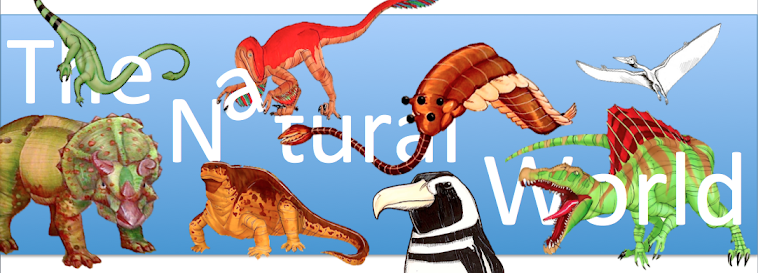For me, last summer was the "Summer of the Giant Ground Sloths." Up until that time, I had only seen a few ground sloth skeletons on display, including the skeleton at The Living Desert in Palm Desert, California and a mounted skeleton of a Harlan's ground sloth (Paramylodon harlani) behind the scenes at the Denver Museum of Nature and Science. But last summer, I got to see mounted specimens at the Mace Brown Museum, the Rocky Mountain Dinosaur Resource Center, and the American Museum of Natural History. The sloth skeleton above is the mid-sized ground sloth Glossotherium, from approximately 1.8 MYA during the Pleistocene Epoch in Florida. The arm below is from the enormous Eremotherium, one of the earliest South American animals that migrated into North America during the Great American Interchange, approximately 2.2 MYA. This specimen is thought to be approximately 1.6 MY old, from Florida. That little sign placard next to the arm was probably about 2x3 inches. These sloths were simply enormous.
I also got my first good look at a bizarre group of bizarre, dermal-armored animals known as pampatheres. Below, we have the giant armadillo-like pampathere Holmesina septentrionalis from the Pleistocene Epoch, between around 2 - 1.5 MYA, also from Florida. According to the signs, Holmesina is one of the largest pampatheres, and was given its current name by the famous paleontologist George Gaylord Simpson, which can be read by clicking HERE. Originally, Holmesina was described as a species of Glyptodon by Joseph Leidy, who later thought that the animal was actually a type of giant armadillo, but Simpson was able to set the record straight in 1930. This animal is in the same order as the armadillos and the glyptodonts, and like the other two groups, is completely covered in dermal armor. The second picture shows a close up of that dermal armor on the front legs.
This picture displays the skulls of two rodents. The one on the left belongs to Castor canadensis, the North American beaver. The one on the right, however, that is freaking huge, is also from a beaver, just a gigantic extinct beaver. Meet Castoroides ohioensis, a beaver the size of a black bear! From what I have been able to find, it is unknown whether Castoroides built dams like its modern counterpart. What is known is that it was one gigantic enormous beaver.
I also got to see my first fossil penguin (cast or otherwise) not still surrounded by matrix. This is a cast of the skull of the penguin Palaeospheniscus, a genus of fossil penguin that was abundant during the Miocene of South America. Their fossils have been discovered in Peru and Argentina, both places where penguins of the genus Spheniscus, such as the Magellanic and Humboldt penguins, are found today.
Works Cited:
Johnson, K., & Miller, I. (2012). Digging Snowmastodon: Discovering an Ice Age world in the Colorado Rockies. Denver, Colo.: Denver Museum of Nature & Science ;.
Ksepka, D. (2012, June 28). Penguins in the Food Chain. Retrieved June 10, 2015, from https://fossilpenguins.wordpress.com/2012/06/28/penguins-in-the-food-chain/
Ksepka, D. (2013, September 19). IPC Roundup 3: Mountain Penguins. Retrieved June 10, 2015, from https://fossilpenguins.wordpress.com/2013/09/19/ipc-roundup-3-mountain-penguins/
Simpson, G. (1930). Holmesina septentrionalis, Extinct Giant Armadillo of Florida. American Museum Novitates, 442. Retrieved June 10, 2015, from http://digitallibrary.amnh.org/dspace/bitstream/handle/2246/3059//v2/dspace/ingest/pdfSource/nov/N0442.pdf?sequence=1
(2014, July 5). Mace Brown Natural History Museum Labels. Charleston, South Carolina.








No comments:
Post a Comment